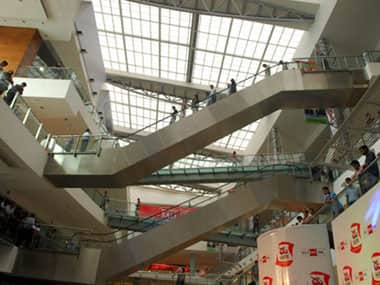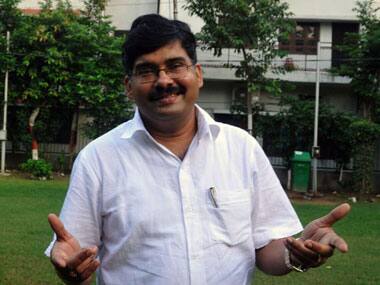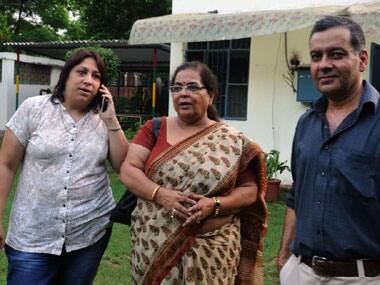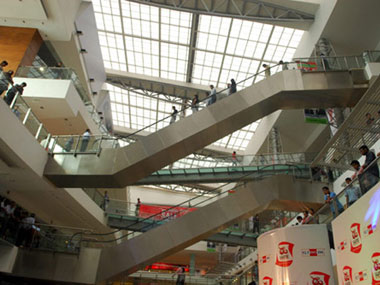New Delhi: The hellish prospect of living in the middle of a perpetual traffic jam has united three of Delhi’s upper middle class neighbourhoods to fight the construction of a giant mall - projected to be the second biggest in Delhi - on a 3.7 acre piece of land that they believed was reserved for a community sports complex.
The land allocated to the mall is bang in the middle of a residential neighbourhood in Alaknanda and shares one of its boundaries with a school.
Perhaps, the first such mall to venture into residential spaces, the Reliance Industries project is facing stiff opposition from very high net worth individuals who could well also be the proposed mall’s patrons.
The Citizens Alliance, a vocal network of residents who have come together to oppose the commercial project, organised their first public rally last month with a one-point agenda -‘Stop the Mall’. An estimated 1,000 people showed up.
[caption id=“attachment_1023813” align=“alignleft” width=“380”]
 The land allocated to the mall is bang in the middle of a residential neighbourhood in Alaknanda and shares one of its boundaries with a school.
Getty Images[/caption]
According to the Alliance, resident welfare associations (RWAs) of all three neighbourhoods that will be affected by the project - Alaknanda, Greater Kailash II and CR Park - have unanimously opposed the project.
Impact Shorts
More ShortsThe support for the campaign, says members of the Alliance, spans across the spectrum. “From DDA flats in Kalkaji to the top-end neighbourhoods of GK II, residents have come out in protest of the project. For the first time, we have come together as a single community. We started with an email group of 10 members, none of us knew anyone from outside our colonies. Now we are over 1,000 members,” says Ashutosh Dikshit, president of the Citizens Alliance.
The Alliance, in the five months it has been active, has succeeded in marginally impacting the corporate giant’s plans.
An Economic Times report (dated 8 August) quotes a ‘person with direct knowledge of RIL’s retail plans’, as saying: “The company had decided to follow a ‘wait and watch’ attitude, after the protests gathered momentum. The company is the process of executing several projects. It has plenty on its plate. It is in no hurry to complete the Alaknanda mall. All its documents for the plot are in order.” ( Read full report here)
A minor victory for the Alliance?
“This is not a victory for us. Slowing down on the project means nothing to us. Six years down the line, we are still going to be living here,” says Suchita Kacher Meena, a resident of Alaknanda.
Meena, who is part of the Alliance team in charge of social media, says they are dead serious about stopping the mall. “Candle-light protests in my opinion are a waste of time. We are interested in doing things that will get a positive response. We are not here to create a tamasha. This is serious business,” she says.
For residents, the mall has come to represent a direct threat to life as they know it.
“One gets really angry about it. What gives them the right to do this?” asks Charushilla Narula, a resident and Alliance member.
[caption id=“attachment_1023837” align=“alignleft” width=“380”]  K R Ramamoorthy, general secretary of the federation of Alaknanda RWAs, says the malls impact on the neighbourhood’s water supply is a big concern.[/caption]
Making the point that their fight first and foremost is with the Delhi Development Authority (DDA), Dikshit says, “Our fight is based on facts, it is based on challenging the violation of laws. The layout plan was changed and government officers have shown a callous disregard for public interest by simply kowtowing to corporate interests.”
The DDA, however, has denied any wrongdoing. The Times of India quotes the DDA spokesperson as saying, “… Since it is a commercial area, it was put to tender in 2007 and sold on a freehold basis for Rs 304 crore. There was never any proposal for a sports complex.”
On some of the major concerns residents have with sharing their neighbourhood with a mall, Dikshit says, “One severely damaging impact would be that of huge traffic jams. There are schools here. Already, we have jams every time there is a PTA meeting and when it rains. All exit points out of this area are choke points. Should a disaster hit, residents won’t be able get an ambulance or a fire brigade here on time.”
Adds Meena Gangahar, resident of GK-II, “And what about personal emergencies. If you want to reach a doctor, you won’t be able to. Traffic is going to become a nightmare. We won’t be able to get out of our houses, just like here.”
Another key concern is safety. With the memory of the 16 December gang rape still fresh, fears of such an incident are high.
Says 16-year-old Mahir Amir, an active ‘Stop the Mall’ campaigner, “My sister’s security is more important to me than anything else. You saw what happened in the Nirbhaya case. That is one reason why I don’t want the mall to come.” Interestingly, a dynamic group of teenagers from the neighbourhood have become active forces in mobilising support for the Allinace.
For parents, the mall represents all kinds security, health, and lifestyle threats. “There are six to eight schools which are within a radius of 1 km. (By constructing a mall) we are basically bringing a negative element closer home. We are creating a setting for another Nirbhaya. Our children will get followed right up to their homes,” says Narula.
Adds Meena, “The mall will be a big attraction for children in the evenings. Every time there is a power cut, they’ll go to the mall and eat junk food. Instead of playing in the park, they will hang out in the mall. The children will be attracted by the fact that there is a pub right at their doorstep.”
The effect on senior citizens is another big worry.
“At the public rally, one of the senior citizens stood up and said that the reason he had bought a house in Aravali (a colony in Alaknanda) was because he wanted a peaceful and quiet life. He went on to add that should he fall ill, he was worried if he would be able reach the hospital on time even with present levels of traffic,” said Meena.
[caption id=“attachment_1023835” align=“alignleft” width=“380”]  Members of the Citizens Alliance - a network of residents from the three neighbourhoods that will be affected by the construction of the mall - say they will fight tooth and nail to stop the project. In pic (from left) Suchita Kacker Meena, Meena Gangahar and president of the Alliance Ashutosh Dikshit. Pic by Naresh Sharma /Firstpost[/caption]
The massive electricity and water cost of the mall has residents of worried. As per the application for approval to the State-Level Environment Impact Assessment Authority, daily water and power consumption is listed as 2 lakh litres and 4 MW.
Says KR Ramamoorthy, general secretary of the Federation of Alaknanda RWAs, “The first thing that struck me when I learnt about the mall was its impact on water supply. The Jal Board supplies half our water and for the rest we depend on ground water. Naturally that will go for a toss once the mall comes up. Already, we have a water problem here.”
He contests the claim that a mall in the neighbourhood will lead to a rise in property prices. “With this kind of traffic congestion and infrastructure problems, who will want to live here?” he asks.
Drawing attention to the commercial impact the mall will have on local markets, Meena says, “There is going to be a major commercial impact of this mall. There are eight-ten small markets that are located here. And there are a large number of vendors who come into our colony to sell vegetables. This mall will also impact markets in GK-1 and GK-2, which have already been affected by the Saket mall.”
Economist Laveesh Bhandari, a resident and treasurer of Citizens Alliance, says his first reaction was what the mall actually meant in terms of scale. “We could not visualise it. Was it a large mall or a small one? The first thing we did was to look at some of the malls in Delhi. And it turns out, after Select Citywalk mall, this would be the largest one. That was very surprising for us.”
Indicus Analytics, a research firm founded by Bhandari, undertook a study to understand the mall’s implications for the neighbourhood’s infrastructure. Based on projections made by their study, the roads won’t be able to cope with the traffic levels that the mall will attract.
Bhandari further argues that constructing a mall in such a situation is a suicidal business project.“All malls make money in peak-hour foot falls. They lose money in non-peak hours. If the peak hours are going to be clogged, the whole return on investment is going to be affected. It is not just the residents who will lose out, Reliance too will not make money. This model won’t work.”
The Alliance says the next course of the campaign will depend on the outcome of their meeting with the Lieutenant Governor of Delhi.
Says Dikshit, “We are trying to meet the Lieutenant Governor of Delhi because he is the de-facto head of the DDA. We will continue to try to meet him. We have made several requests. We will go as a delegation. All the RWAs in this area are dedicated to the campaign.”


)

)
)
)
)
)
)
)
)



